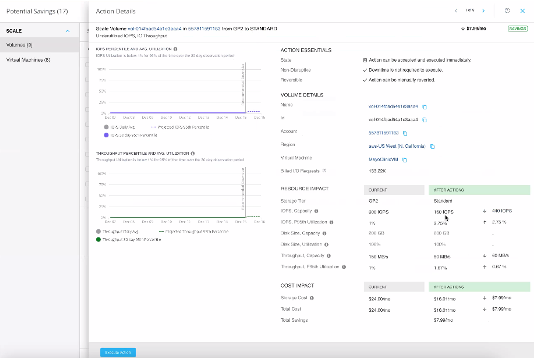- CIOs must mind their own data confidence gap
- Data-stealing cyberattacks are surging - 7 ways to protect yourself and your business
- Update your iPhone now to patch a CarPlay glitch and two serious security flaws
- CISA Throws Lifeline to CVE Program with Contract Extension
- US Senators Push for Stronger Cybercrime and Computer Fraud Legislation
Simplify multi-cloud operations: How to optimize AWS, Azure, and GCP workloads with IWO

This is the final blog in a series on cloud optimization. Also see “Reduce Public Cloud Spend with Intersight Workload Optimizer” and “Getting to the cloud: How IWO can help you plan cloud migration.”
In this interview I talk with Mike Isaia, technical solutions architect, about the trend toward the use of multiple public cloud providers and how Cisco Intersight Workload Optimizer simplifies performance and cost optimization across AWS, Microsoft Azure, and Google Cloud Platform (GCP).
Q: Today, organizations are often using more than one public cloud provider. What’s driving multi-cloud operations?
A: As the use of the public cloud continues to rise, IT leaders are realizing that it can be wise to diversify their public cloud providers. Two main reasons are to prevent vendor lock-in and to take advantage of the big three public cloud providers’ individual strengths (AWS, Azure, and GCP). For example, AWS is the biggest player on the market with the greatest breadth of features and capabilities. Microsoft Azure is, of course, best-of-breed for Microsoft products, and GCP emphasizes data analytics.
Q: Why is operating workloads across a multi-cloud environment challenging?
A: There are a couple of main reasons. First, AWS, Azure, and GCP are completely different vendors who provide cloud services in different ways. From a computing perspective, each has its own full computing architecture. They each have unique service catalogues, families, instances, and billing, and each one functions differently. For example, whereas GCP uses sustained-use discounting, AWS uses reserved instances. Each one has specific ways to manage workloads and address resource and performance issues, but you have to know how each cloud provider works and use each vendors’ proprietary tools.
This requires skillsets to know the details of effectively managing each cloud provider along with the time to learn and use multiple cloud operations tools.
Second, application resource demands and public cloud resources are always changing. This means that someone always has to adjust resources across each of your cloud environments to ensure applications are getting the resources they need, not more and not less. Your team also has to stay on top of the thousands of services offered by public cloud providers and their continuously fluctuating costs. You have to be able to know which services you need and how to adjust workloads to make sure you’re supplying the right resources at the lowest possible cost.
In other words, the operational complexity of operating a multi-cloud environment is enormous. It’s not humanly possible to keep up with all the continuously changing workload and cloud provider information, which can result in degraded application performance and greater spend.
Q: How can cloud ops and IT teams simplify cloud operations across multiple providers?
A: The jump that needs to take place to get the benefit of multi-cloud must come through orchestration and automation across your entire cloud infrastructure, no matter how many providers you use.
But I like to go back to a basic cloud fallacy. A lot of people say the promise of the public cloud is that you pay only for what you use. This isn’t true. You pay for what you ask to use, so you need to make sure that what you’re asking for across each provider is what you need. If you don’t, cost becomes an issue.
With this said, how do you know what workload resources to ask for across multiple cloud providers? And how do you do this without adding more tools or making it harder for your team? The answer is to consolidate cloud resource management into a single application resource management solution that gives you the visibility and information to make decisions relative to fluctuating workload requirements and operational inputs across each cloud provider.
Cisco Intersight Workload Optimizer, or IWO, is Cisco’s SaaS-based application resource management solution that provides these capabilities.
Q: How does IWO simplify multi-cloud operations?
A: Intersight Workload Optimizer solves several critical, multi-cloud operations challenges:
- IWO is cloud-agnostic. It integrates with AWS, Azure and GCP, consolidating public cloud operations into a single dashboard so you only need to use one tool.
- IWO eliminates the need to track services, costs, etc., from each cloud provider (no more spreadsheets!). It ingests detailed information from each cloud provider and provides the intelligence to surface recommendations based on your contractual agreements (such as licensing and pricing), and it makes proactive recommendations to help make sure you’re continuously optimizing both your workloads and costs.
- IWO lets you automate workload and cost optimization based on IT-approved actions to continuously ensure performance at the lowest cost.
- And finally, IWO supports more than two dozen third-party applications—from application performance management, compute and container platform management to tools for storage arrays and hyperconverged infrastructure management. This helps you build a bridge from your existing tools to a consolidated view into your application resource supply chain.
Q: What are some examples of how IWO optimizes workloads and costs in the public cloud?
A: Here are a few examples of how cloud ops teams can manage workloads and cost in AWS, Azure, and GCP using IWO:
- Global cloud footprint: You can see your entire public cloud presence globally (figure 1). IWO will identify if placing a workload in one geography is more expensive than another and recommend how to adjust workload placement—while conforming to your compliance policies—to reduce costs without compromising application performance.
- Storage optimization: Storage is an area where public costs can often be higher than expected. Remember, you pay for what you ask to use. Make sure you’re asking to use only what you need. IWO shows you what your current storage costs look like, such as how much solid state disk capacity you’re paying for versus what you’re actually using. It recommends actions, such as using standard disk storage in this example (figure 2), to bring the cloud resources you’re asking for in alignment with what your usage requirements actually are.

- Notices for new instance families: Cloud costs decrease with the release of each new instance family. If your team doesn’t know when a new instance family is available, and if they can’t take the required action to adopt it, you lose the opportunity to reduce costs. IWO automatically notifies you when a new instance family is available. It shows you what your costs will be if you continue using the current family versus moving to the new one, along with estimated cost savings.
- Customized Recommendations: IWO customizes recommendations to your contractual agreements with each cloud provider. If you have discounts, it makes performance and cost recommendations based on them rather than standard public pricing.
- Potential savings over time: IWO shows you the cost saving you can achieve over time if you take recommended optimization actions (figure 3).

- Decrease downtime: IWO also integrates with application performance management tools like Cisco AppDynamics, Dynatrace, and others. This lets your team see the real-time health status of the entire stack. You can see if wait time for a page to load is sluggish, for example, and immediately identify if the root cause is related to application resources in any of your cloud environments (figure 4). If so, IWO identifies the issue and makes a recommendation on how to resolve it.

Q: What final thoughts do you have about simplifying multi-cloud operations? How can someone get started?
A: Organizations are gaining maturity with the public cloud to run applications with more than one cloud provider based on providers’ strengths and their own needs. IWO simplifies cloud operations across AWS, Azure, and GPS through visibility, insights, and action to help optimize performance and cost wherever your workloads run.
Ask yourself, “How much more could we accomplish if we didn’t have to spend 40% of our time figuring out how to size a workload or save 10%?” With IWO, you can engineer waste out of multi-cloud operations to take advantage of a multi-cloud strategy.
or start a 45-day free trial to see what IWO can do for you.
Share:

